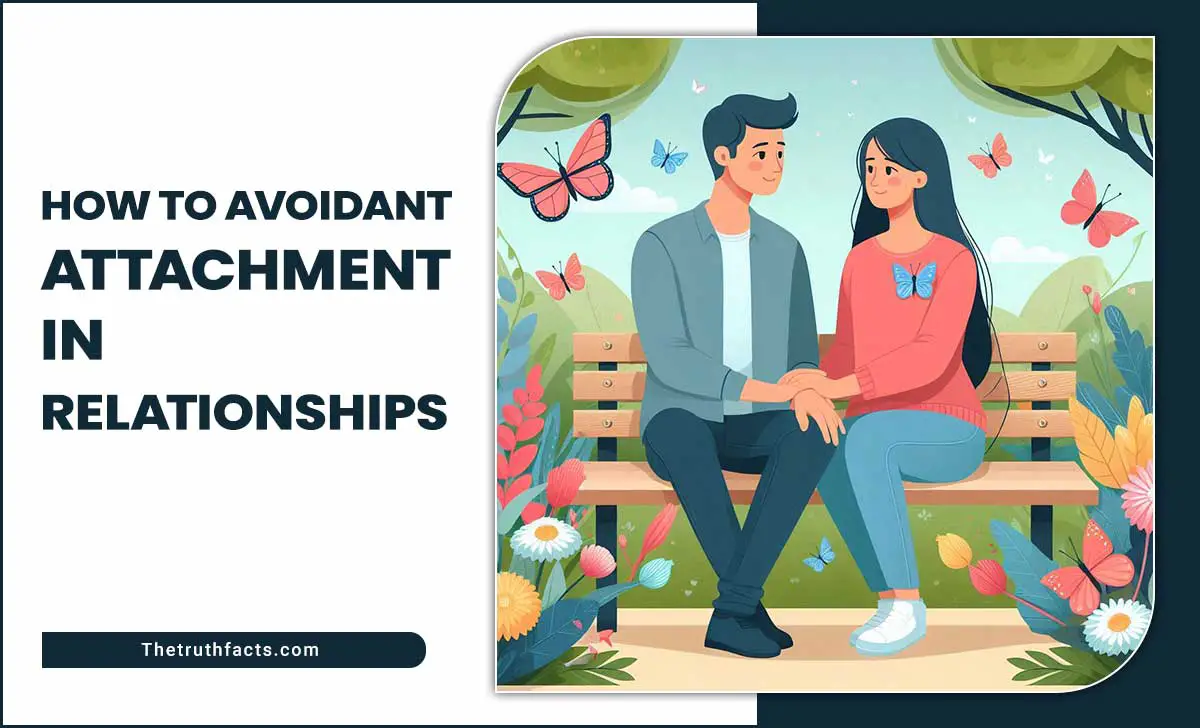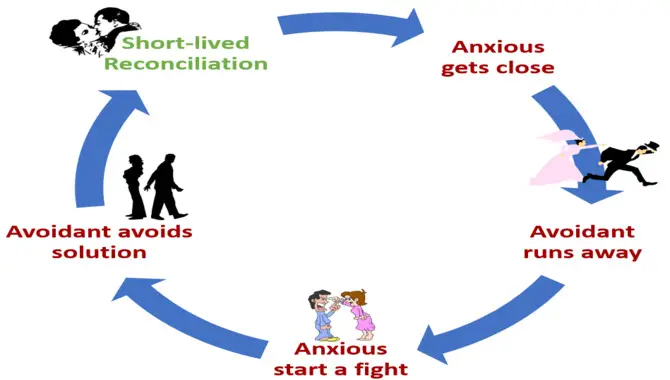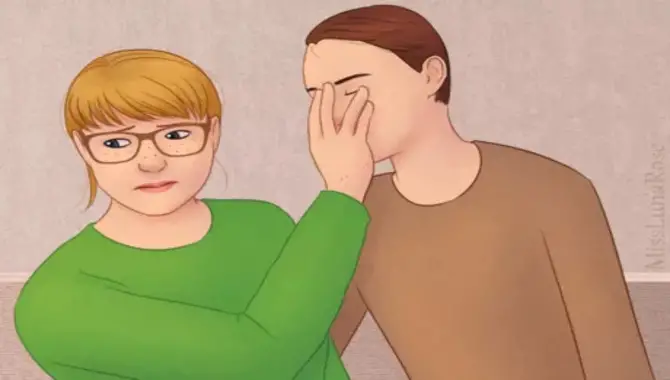Avoidant attachment is a relationship style characterized by a fear of intimacy. It can be a very harmful style as it makes it difficult for her to form secure attachments with people.
In this article post, we will discuss the symptoms of avoidant attachment, how it affects relationships, and how you can overcome it. We also have a special relationship tips section for those struggling with avoidant attachment. So read on to learn all you need to know about avoidant attachment in relationships.

What Is Avoidant Attachment?
Avoidant attachment is a relationship where people are generally afraid or uncomfortable with intimacy. This means that they tend to keep their distance from their partners and often avoid any kind of emotional or physical contact.
The main reason why people develop avoidant attachment is that they experienced intense and/or ongoing abuse in their past. They may also have difficulty trusting other people, which can lead them to believe that intimacy will only lead to more pain. As a result, they stay away from relationships to protect themselves.
What Are The Symptoms Of Avoidant Attachment?

If you’re struggling in your relationship, one of the most likely reasons is that you might suffer from avoidant attachment. Avoidant attachment is an emotional relationship disorder in which individuals have difficulty forming trusting and secure attachments. This can lead to some problems in a relationship, including:
It’s difficult for either party to open up and share their feelings. There’s often tension and conflict because neither person trusts the other enough to be safe and open with them. The couple doesn’t feel connected because they don’t trust each other enough to share important thoughts and feelings. They struggle to build intimacy because they’re too afraid of being hurt again.
They often feel lonely and abandoned because they don’t trust that their partner will stay by their side no matter what. There are many ways to overcome avoidant attachment in a relationship, but the first step is always finding help. If you’re worried that your relationship might be suffering from this problem, speak to your doctor or therapist about how he or she might be able to help you.
7 Types Of Avoidant Attachments In A Relationship

People who are avoidant attachment in a relationship often feel lonely and unfulfilled. They often have difficulty forming close relationships because they fear being hurt again. There are seven types of avoidant attachment in a relationship:
1. Avoidant Attachment Strategies :

In avoidant attachment strategies, individuals keep themselves at a distance from relationships in order to protect themselves. They may become preoccupied with their own needs and feelings and may be unwilling or unable to invest time and energy in relationships. This can lead to problems in a relationship because the individual cannot provide the emotional security necessary for a healthy relationship. They also tend to be less responsive to their partner’s needs, which can cause frustration and tension.
2. Disinhibited Attachment Styles :

There are two disinhibited attachment styles – secure Avoidant Attachment and insecure Avoidant Attachment. People with a secure, Avoidant Attachment style tend to be very independent and self-reliant. They are comfortable with not being attached to anyone and believe they can handle any situation alone. They also tend to be critical of their relationships and aren’t afraid of abandonment or separation.
On the other hand, people with an insecure Avoidant Attachment style are afraid of being alone and lack self-confidence. They often rely on their partners excessively and become fixated on them in a way that leads to them feeling overwhelmed and controlled. This often results in unhealthy dependency, low self-esteem, and feelings of insecurity and vulnerability.
3. Withdrawal- Shyness- Detachment :

Avoidant attachment is a related disorder in which individuals attach themselves to avoid potentially negative relationships. This can lead to shyness and detachment, as the person becomes unsure of how to interact with others. They may also become overwhelmed by their emotions when in a relationship and avoid socializing or intimate activities.
This type of relationship can be difficult to cope with, as it often leads to feelings of isolation and loneliness. It can also be difficult to develop positive relationships due to the fear of being hurt again. If you are experiencing any of these symptoms in your current relationship, it may be time for you to seek professional help.
4. Detached Attachment:
Avoidant attachment is a relationship attachment characterized by a lack of emotional investment. People with avoidant attachments often have little or no interest in forming close relationships and may be unwilling to share personal information or feelings with their partners.
This can make it difficult to build a strong foundation for a relationship, as avoidants tend to take things for granted and assume that their partners will always be there for them. This can lead to problems when things go wrong, as avoidants are not typically good at asking for help or communicating their needs.
5. Fearful Avoidance:
Avoidant attachment is a dysfunctional relationship where one or both partners suffer from fearful avoidance. This means that they avoid any potential negative consequences that may come from their relationship. As a result, the relationship becomes incredibly unstable and difficult to maintain.
Avoidant attachment usually occurs in relationships where one or both partners are insecure and have low self-esteem. They feel afraid of being hurt again, which leads them to stay away from any situation or person that might make them feel vulnerable. As a result, they attract partners who share these same characteristics, making the fear bigger and the avoidance stronger.
6. Intrusive Attachment Style:

People with an intrusive attachment style (or avoidant attachment) are very clingy and insecure in their relationships. They often feel like they need to be close to their partner all the time to feel safe and secure. This can make it difficult for them to let go of their partner, even when not needed.
This relationship is usually unstable because it’s based on fear rather than trust. This means that both partners are always on guard, which makes it difficult to build a strong foundation for a healthy relationship. It’s also tough for the avoidant partner because they never really learn how to communicate with others effectively, which means that problems tend to fester until they explode.
7. Secure Attachment Style:
An avoidant attachment style is characterized by a lack of interest in relationships and a tendency to depend on others. People with an avoidant attachment style often have problems forming secure attachments because they fear being abandoned or hurt again.
The consequences of having an avoidant attachment style can be significant. People with this style often have low self-esteem and little confidence, and they often find it difficult to form close relationships because they don’t feel safe. They also struggle to trust others, leading to problems in their work or social lives.
How To Overcome Avoidant Attachment In A Relationship?

There are a few ways to overcome avoidant attachment in a relationship. One way is to work on building trust and understanding each other better. Can do this through honest and open communication and being willing to listen without judgment. Another way is to work on resolving conflict together calmly and thoughtfully.
When both parties committee to constructively resolving conflicts, it will help build stronger ties. Most importantly, however, both parties must understand that their relationship is based on mutual respect and love. If either of these two things is missing, then the relationship will doom from the start.
Relationship Tips For Those With Avoidant Attachment

It can be tough to connect with your partner if you’re in a relationship with an avoidant attachment. This type of attachment characterize by a lack of trust and a fear of abandonment. As a result, it’s difficult for people with this type of attachment to form strong relationships.
Here are some tips that may help:
Make sure you’re open and honest with your partner about your feelings. Trying to sugarcoat things or skirt the issue will only make things worse. Be assertive without being pushy or aggressive. Instead, build a relationship where both of you feel comfortable voicing your opinions and disagreements. Communicate regularly even if everything you say feels like it’s coming out wrong. The more open and communicative you are, the better your partner’s chance of understanding and respect you.
Conclusion
Avoidant attachment is a relationship problem that can harm both parties. By understanding the symptoms of avoidant attachment and how to overcome them, you can create a healthy and fulfilling relationship. In addition to relationship tips, we have included a list of relationship problems caused by avoidant attachments for you to consider. So, whether you are in a relationship or looking to get into one, read this complete guide to the avoidant attachment.
Frequently Asked Questions:
What Is Avoidant Attachment, And How Does It Lead To Problems In A Relationship?
Avoidant attachment is a relationship in which individuals have low self-esteem and insecurity. As a result, they avoid relationships altogether or become extremely clingy and paranoid in their attachments. This type of attachment can lead to problems in a relationship because it prevents intimacy and communication from developing properly.
What Can I Do If I’m Struggling With Symptoms Of Avoidant Attachment Myself?
You must talk to a therapist if you’re struggling with avoidant attachment symptoms. This is because this attachment style is often associated with emotional pain and suffering. Sharing your feelings and story with a therapist can be very helpful in identifying the triggers that cause you emotional distress. Additionally, it can be helpful to keep track of your symptoms over time so that you can better understand why they occur and learn how to manage them.
How Can I Best Support My Partner’s Journey Toward Healing From Avoidant Attachment Disorder?
Communicating with them is the first step in supporting a partner during their journey towards healing from Avoidant Attachment Disorder. You must be understanding and supportive and avoid putting too much pressure on them. Additionally, help your partner find healthy ways of coping with their emotions, such as expressing themselves, seeking help from friends or family, or going for walks.
What Should I Do If I’m Feeling Avoidant Attachment In A Relationship?
If you’re feeling Avoidant Attachment in a relationship, the first step is to understand that you are not the only one. This attachment style often occurs in people who attach emotionally to unavailable or unreliable people. As a result, they often find themselves in a cycle of neglect and hurt feelings because they feel like they can’t rely on anyone else for support.
How Can I Help My Partner Overcome Their Avoidant Attachment?
One way to help a partner overcome their avoidant attachment is through cognitive behavioral therapy. This therapy helps the partner learn how to change their thinking and behaviors to overcome their avoidant attachment. Another way to help a partner is through self-compassion and validation. Being understanding and supportive without pushing too hard or taking control is important in helping a partner overcome avoidant attachment. Spending time for yourself helps in building trust and a healthy relationship.

I’m a writer and blogger who loves to talk about entertainment, culture, and relationships. I love to share my thoughts and insights on these topics, and I’m always looking for new ways to engage with my readers. I’m also a big fan of learning new things, so I’m always exploring new areas of interest.
